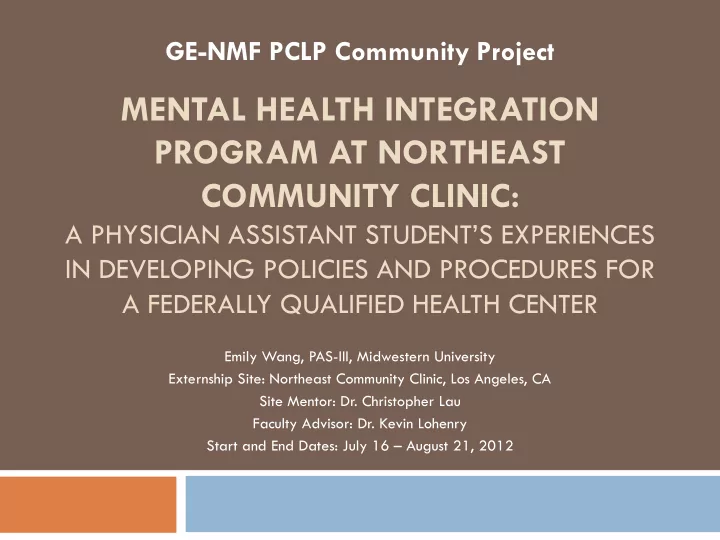

GE-NMF PCLP Community Project MENTAL HEALTH INTEGRATION PROGRAM AT NORTHEAST COMMUNITY CLINIC: A PHYSICIAN ASSISTANT STUDENT’S EXPERIENCES IN DEVELOPING POLICIES AND PROCEDURES FOR A FEDERALLY QUALIFIED HEALTH CENTER Emily Wang, PAS-III, Midwestern University Externship Site: Northeast Community Clinic, Los Angeles, CA Site Mentor: Dr. Christopher Lau Faculty Advisor: Dr. Kevin Lohenry Start and End Dates: July 16 – August 21, 2012
Introduction PAS-III at Midwestern University in Glendale, AZ Originally from Fremont, CA (San Francisco Bay Area) Completed undergraduate education at UCLA Wanted to return to help underserved populations in Los Angeles
Why I Chose this Topic My original project idea of organizing a bone marrow registry drive was too constricted. Would not benefit NECC’s patient population Mental health is one of my professional interests. Wanted to see how programs for federally qualified health centers (FQHC) are developed. Wanted to learn more about the business and administrative side of medicine. NECC wanted to roll this project out soon.
Background: U.S. and California According to Healthy People: In 2004, 1 in 4 adults had a mental illness in the past year, and 1 in 17 had a serious mental illness (SMI). Serious mental illness – a condition listed in the Diagnostic and Statistical Manual of Mental Disorders (DSM) that has persisted for at least 12 months and causes significant impairment in the patient’s life M ultiple studies have shown a link between a patient’s mental health and his physical health. According to the National Alliance on Mental Health (for CA): In 2006, 3,334 people committed suicide. As of 2010, 3.19% of adults are living with SMIs. In 2010, California’s mental health services were only meeting the needs of 34% of adults living with SMIs.
Background: Los Angeles County California Health Interview Survey Data for Los Angeles County Federal Poverty Level 0-99% 100- 200- 300+% 199% 299% Likely has had serious psychological distress during 10.5% 8.8% 7.3% 5.3% past year Severe work impairment past 12 months 10.3%* 3.2% 3.4% 4.3% Needed help for emotional/mental health 16.6% 12.8% 15.9% 16.2% problems or use of alcohol/drug Has taken prescription medicine for 11.9% 6.9% 9.6% 9.2% emotional/mental health issue in past year Had difficulties/delays getting mental health care 6.8% 4.8% 6.5% 5.0% Received emergency room care for 12.0% 10.5% 7.8% 4.6% emotional/mental issues during past year Mental health treatment covered by insurance 61.0% 68.0% 88.7% 83.9% *Statistically unstable.
Methods I read many government documents about LA County’s low -income health program, called Healthy Way LA (HWLA). HWLA partnered with LA County’s Department of Mental Health to implement a Mental Health Integration Program (MHIP). The MHIP will offer mental health services in a tiered structure based on the patient’s symptom severity and eligibility criteria. NECC needs a new internal program to accommodate new HWLA mental health patients.
Methods I worked primarily with Bernard Carrillo, a physician assistant at the clinic who also doubles as the Clinic Services Administrator. Screening forms: PHQ 9, GAD 7, MDQ, PCL C Picked questions from each one to make CMAP , NECC’s Comprehensive Mental Assessment Plan Positive responses on CMAP triggered need for patient to fill out more specific forms to screen for specific mental disorders
Methods Workflow algorithm Very time consuming First time working with Microsoft Visio Needed for all NECC treatment plans Policies and Procedures Also very time consuming Also needed for all NECC treatment plans
Conclusions and Future Plans Administrative work for large organizations like NECC (11 clinic sites) is very time consuming and detail oriented. County contracts are difficult to process and very bureaucratic. There are still many factors to consider before the MHIP can be rolled out at NECC, including: Hiring new counselors (LCSW) Contracting psychiatrists and other mental health services providers Develop billing processes Explain new program to medical providers and LCSWs
Recommendations to Future Scholars No “results” in the traditional sense because I did not collect any data. Would have liked to see how many patients would be referred to mental health services to see if the CMAP screening tool is valuable and yields a high referral count. If I were to redo this project, I would choose a program that is already in existence so I could collect data. However, I still learned a tremendous amount about county policies, FQHC administration, using new software, and designing new programs. I greatly enjoyed my experience and am extremely grateful for the opportunity!
Acknowledgements GE Foundation National Medical Fellowships Dr. Christopher Lau, executive director of NECC and my site advisor for the program Jane Rhee, Dr. Lau’s executive assistant Bernard Carrillo, PA-C and Clinic Services Administrator Dr. Kevin Lohenry, my faculty advisor
Recommend
More recommend